That Time a German Prince Built an Artificial Volcano
A 18th century German prince visited Mt. Vesuvius and built a replica of it. 200 years later, a chemistry professor brings it back to life
/https://tf-cmsv2-smithsonianmag-media.s3.amazonaws.com/filer/Volcano-20120825-Volcano-136-Flash.jpg)
The smoke began rising above the farm fields and tidy forests of Woerlitz last Saturday morning, puffs of white and black that signaled something unusual. By sunset, thousands of people had gathered on the shores of an artificial lake, listening avidly to ominous rumbles. Dozens more, tipsy with schnapps and wine, floated in candlelit gondolas on the still water.
They were all here to see Europe's biggest, oldest and—as far as anyone knows—only artificial volcano. Completed in 1794, the Stone Island of Woerlitz is a little-known wonder of the Enlightenment, a provincial prince's attempt to bring a bit of Italian drama and grandeur to the farmers of Germany.
Today it's part of the Garden Realm of Woerlitz, a Unesco World Heritage site about an hour's drive south of Berlin. But just a decade ago, this odd structure was condemned, a decrepit ruin covered over with weeds and crumbling stone. After a five-year restoration project, the "volcano" was safe—but silent after nearly two centuries of neglect.
In 2004, the World Heritage site’s management turned to Wolfgang Spyra, an enthusiastic chemistry professor at the Brandenburg Technical University with a side interest in historical pyrotechnics, to bring the volcano back to life. “A volcano that can’t explode is a very sad volcano, and I wanted to make it happy again,” Spyra says. "We wanted to help the volcano get its identity back."
But first, Spyra—who spent a decade as the head of Berlin’s criminology lab and signs his e-mails "the Eruptor"—had to do a little historical detective work to figure out how an artificial volcano had risen out of this decidedly un-volcanic region of Europe in the first place.
The trail led back to Leopold III Friedrich Franz, prince and duke of Anhalt-Dessau, who ruled a small kingdom near the modern-day town of Dessau in the 18th century. Born in 1740, Franz was an unusually enlightened ruler, even for the Age of Enlightenment. In his mid-20s, he went on a grand tour of Europe, a rite of passage for the continent's nobility.
Franz's travels took him to London, Paris, Marseilles, Rome, Venice and Naples, where the 27-year-old princeling was captivated by the smoldering Mount Vesuvius and the recent discovery of the buried Roman town of Pompeii.
"Vesuvius must have really impressed him, because 22 years later he came up with the idea to re-create the Gulf of Naples in flat Germany," says Uwe Quilitzsch, the Woerlitz Garden Realm's staff historian. "He saw himself as obliged to enlighten his subjects, and he saw this as a lesson for people who would never get to Naples."
While preparing for the night’s eruption, Spyra and Quilitzsch explain some of the volcano's secrets. Franz had his architects build a brick inner building nearly five stories high and cover it with local boulders. At the top, a hollow cone housed a high-ceilinged chamber with three fireplaces. The building's roof also included an artificial "crater," which could be filled with water.
Nearby, Franz built a Greek-style amphitheater and a small villa to serve as his personal study and flooded the corner of his estate to surround the "Stone Island" with water. Then, according to historical accounts, he invited his friends to watch his personal volcano erupt.
But even though the structure had been carefully reconstructed, Spyra and his team didn’t have much to go on when it came to re-creating the event: Only one contemporary image of the volcano’s eruption, a painting from 1794, exists. “We needed to figure out if it was a realistic depiction or fantasy,” Spyra says.
Spyra wondered if the sole surviving painting of an eruption reflected reality or was a painterly exaggeration. By comparing the size of the volcano in the painting to the size of the real thing, which rises nearly 56 feet above the river that flows past, he could then tell that the smoke in the painting represented a cloud 30 feet high. That, he says, meant the smoke could have been from a natural source—and that the painting was a good guide to what the original "eruption" looked like.
But what kind of wood would they have used? Why was the volcano so far removed from the rest of the prince’s property? Why were there three separate fireplaces concealed in a brick-lined chamber under the volcano’s peak?
Ironically, the most important clues came from a contemporary critic named Carl August Boettinger, who wrote a lengthy eyewitness report in 1797 ridiculing the spectacle of a volcano plunked down in the middle of the eccentric prince's estate. While making fun of Franz, Boettinger described the "eruption" in detail—from the water released from the concealed "crater" at the top of the volcano to simulate lava to the red lamps that gave the pile of stone an otherworldly glow.
With that to go on, "we started out by researching what the people of the time might have used for fireworks," Spyra says. Gunpowder, pitch and sulfur were readily available to 18th-century pyrotechnicians, most of whom were military men intimately familiar with explosives. Bengal fire—a bright blue or red flame not unlike today's road flares—was also well-known.
As re-created by Spyra, the event is impressive, even to 21st-century eyes accustomed to special effects and fireworks. As the twilight deepened into what German poets call the "blue hour," that moment just before the sky goes black, a deep hush settled over the crowd.
Then, with a final rumble of drums and thunder, the moment arrives: red flames flickered at the top of the volcano, growing into a thick column of smoke.
Red-tinged water begins to flow from the crater, churning the still lake below. Sharp, loud explosions send sparks shooting into the sky. Hidden in the volcano's peak is an 86-square-foot oven packed with fresh pine needles. Once lit, they roar into smoky fire, sending sparks high into the night sky along with the billowing smoke.
As the needles burn above their heads, Brandenburg Technical University students in gas masks rush from fireplace to fireplace in the room below, squirting lighter fluid on blazing wood fires and tossing in special powder to create brightly colored smoke that pours out from underneath the summit of the volcano.
Then, red-tinged water begins to flow from the crater, churning the still lake below. To create the illusion of flowing lava, Spyra first filled the artificial pond at the top of the crater. As the volcanic "eruption" peaks, the water is released over a ledge to form a waterfall, lit from behind by bright red Bengal fire.
Throughout, sharp, loud explosions send sparks shooting into the sky, jolting onlookers with each loud bang. The effect is produced using mortars, familiar to any 18th-century artillery expert.
The experience is a testament to the power of Franz's obsession—and a monument to a pivotal experience of his youth. "He obviously saw it in Italy, and this was the German answer," says Quilitzsch. "By the standards of the time, it was a remarkable achievement."
Yet after Franz's death in 1820 the eruptions ceased. His sole legitimate son had no interest in such diversions. Though most of Franz's elaborately planned "Garden Realm" was preserved after his death, over the next 150 years or so the volcano was neglected. After World War II, the area became part of East Germany, and the volcano fell into further ruin. "The last eruptions were just burning tires," says Heiko Pilz, one of Spyra's graduate student assistants. "It was overgrown with weeds and falling apart." East German authorities finally condemned it in 1983, after part of it collapsed and killed someone.
The volcano still has secrets, of course. "I wonder how they did the noise," says graduate student Jonas Lohmann, dousing the fireplaces with lighter fluid and smoke powder a few hours before Saturday's eruption. "Nowadays we have hi-fi speakers, but back then? No idea."
And just as there's no way to know exactly what contemporary audiences saw when they gathered on the banks of Franz's ersatz Gulf of Naples, we'll never know what they felt as they watched flame and smoke churn out of Franz's flight of fancy.
Skeptical accounts aside, Quilitzsch and Spyra are convinced the volcano must have been a truly impressive—even frightening—sight for Franz's peers and subjects. "They wanted to be transported – the era was defined by poverty and plunder, and people relished spectacles and distractions," Spyra says.
Spyra and Quilitzsch are enthusiastic showmen, but they're also wary of cheapening the volcano's romance through over-exposure. "We don't want to make this into a daily, mundane event," Spyra says.
Since the volcano first rumbled back to life in 2005, Spyra and Quilitzsch have staged just a dozen eruptions, roughly once a year and never on the same dates (this year it was on the anniversary of the A.D. 79 Vesuvius eruption). They won't say when the next eruption will be. Says Quilitzsch: "Would you ask a volcano when it's going to go off?"
/https://tf-cmsv2-smithsonianmag-media.s3.amazonaws.com/accounts/headshot/SQJ_1604_Danube_Contribs_02.jpg)
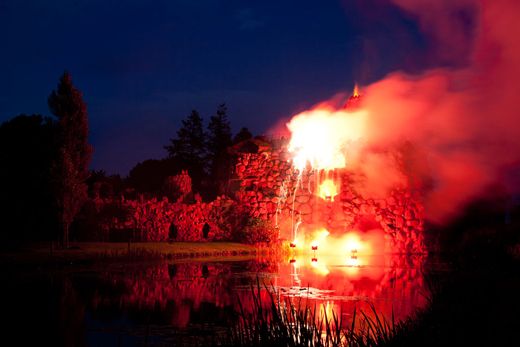
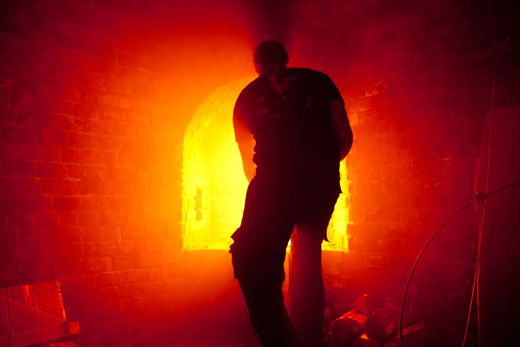
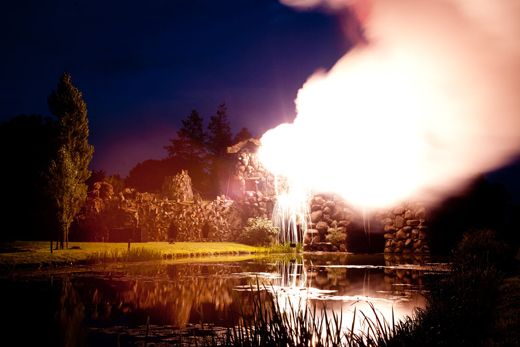
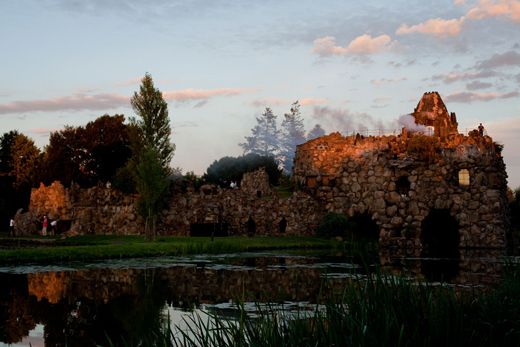
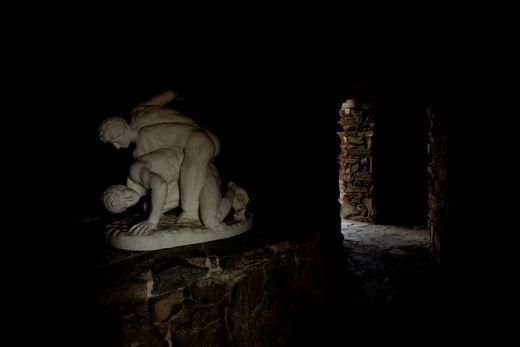
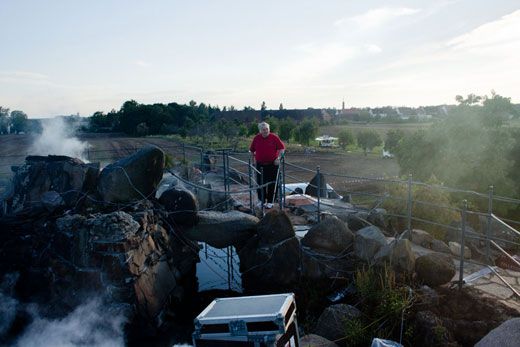
/https://tf-cmsv2-smithsonianmag-media.s3.amazonaws.com/accounts/headshot/SQJ_1604_Danube_Contribs_02.jpg)